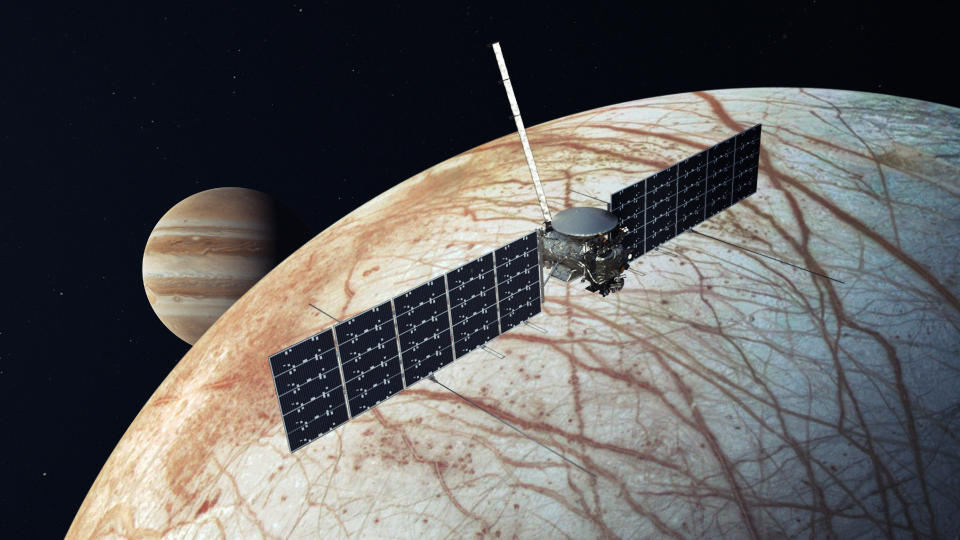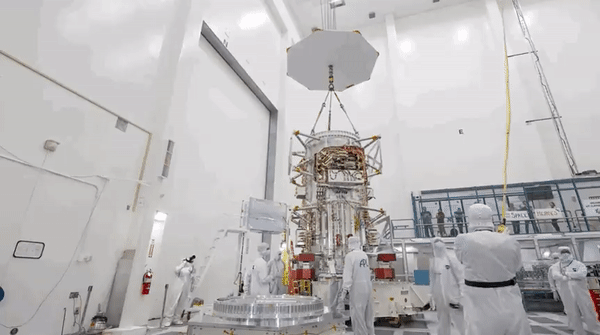When you buy through links on our articles, Future and its syndication partners may earn a commission.


Three weeks from now, NASA’s Europa Clipper probe will lift off and embark on a long-awaited mission to study Jupiter’s icy moon Europa, which scientists think is one of the most promising places to look for life beyond Earth. The launch appears to still be on track for Oct. 10, as per the agency’s original schedule, which comes as a relief to scientists after the team discovered a few possibly defective transistors just months prior that threatened to imperil the mission.
Any signs of life on Europa would likely be hidden in the vast, sunless ocean that scientists suspect sloshes beneath the moon’s icy crust, which is roughly 10 miles (16 kilometers) thick. The $5-billion Europa Clipper will not be searching for life itself, however. Rather, scientists will seek to determine whether Europa has the necessary conditions for life (as we know it, at least).
“There’s very strong evidence that the ingredients for life exist on Europa, but we have to go there to find out,” Bonnie Buratti, who is the deputy project scientist for the Europa Clipper mission, told reporters during a press briefing on Tuesday (Sept. 17). “We’re looking for chemicals on the surface, organic chemicals that are the precursors to life.”
The spacecraft is now being loaded with propellant and is scheduled to launch atop a SpaceX Falcon Heavy rocket from Launch Complex 39A at NASA’s Kennedy Space Center in Florida. If all goes to plan, the probe will arrive at Jupiter in April of 2030, following a cosmic trek of 1.8 billion miles (2.9 billion kilometers).
Related: Why NASA’s Europa Clipper mission to Jupiter’s icy moon is such a big deal
Once at Jupiter, Europa Clipper will not land on its target moon, but instead study it during 49 flybys, searching for a habitable environment where life could thrive. It is the first mission to investigate the habitability of an ocean world.
“We scientists have been dreaming about a mission like Europa Clipper for more than 20 years,” Laurie Leshin, the director of NASA’s Jet Propulsion Laboratory (JPL) in California, said during the news conference on Tuesday. “We’ve been working to build it for 10 years. It’s going to be another 10 years — because Jupiter’s so far away — until we have all the science in the bag. It really is a very long term investment and quest.”
She applauded the 4000+ scientists and engineers who have contributed to the mission since its inception a decade ago, some of whom are now working round the clock to get the spacecraft ready for launch. “We’re incredibly proud of the work that this team has done,” she said.
To confirm whether a global ocean indeed lurks underneath Europa’s icy crust, scientists will look for blips in the spacecraft’s orbit — with an accuracy of meters, sometimes centimeters — known to be caused by the pull of an ocean. “We’ll have a deluge of scientific data within the first few flybys,” Buaratti said.
Meanwhile, the probe’s suite of nine science instruments will work in sync to estimate the thickness of Europa’s icy shell. Scientists are intrigued by remarkably few craters and cracks scarring the moon’s surface, which signal active or recent geology and perhaps interactions with an ocean below, if it so exists.
Europa Clipper could also help reveal whether there are organic compounds that can serve as food for any primitive organisms on the moon, said Buratti. “There are dream things we could observe, like DNA or RNA, but we don’t expect to see those,” she said. “It really is just looking for a habitable environment and evidence for the ingredients of life, not life itself.”


Europa Clipper is equipped with giant solar panels to capture the feeble sunlight reaching Jupiter’s pocket of the solar system and use it for power. When fully deployed, the probe is 5 meters tall and 30 meters wide (16 feet tall and 98 meters wide), making it the largest spacecraft NASA has ever built for a planetary mission.
In fact, a significant challenge during mission development was making such a large spacecraft capable of surviving the intense radiation around Europa, said Jordan Evans, the mission’s project manager at JPL.
During each flyby, “the surface of the spacecraft is exposed to the equivalent of a few million chest X-rays,” he said. So, the mission team designed a trajectory that will dip the spacecraft in and out of the hazardous radiation.
“We fly in, we get the science data we need. We fly out, process the data, send it back to Earth, and then go back for another flyby, where, again, the spacecraft bathes in that radiation environment,” Evans continued.
This workflow will also ensure the possibly faulty transistors on the spacecraft — which scientists feared were less resistant to radiation than expected — have the opportunity to partially recover between flybys. The worrisome transistors “don’t present an appreciable mission risk,” said Evans. “We can — I have high confidence, and the data bears it out — complete the original mission,” he told Nature.
Related Stories:
— NASA’s $5 billion Europa Clipper mission may not be able to handle Jupiter’s radiation
— If alien life exists on Europa, we may find it in hydrothermal vents
— A ‘snowball fight’ may help scientists find life on Jupiter’s moon Europa
The mission is designed to last at least four years. Once it ends, a series of burns will crash it into Ganymede, the largest moon in the solar system and third in distance from Jupiter among the four Galilean satellites. Around the same time, Ganymede will be studied by a different European mission, JUICE, which may be able to observe Europa Clipper’s impact into the moon, said Evans.
For now, however, all eyes are on Europa Clipper’s upcoming launch toward its icy moon target and its tantalizing subsurface ocean.
“Every mission we’ve ever been to we have always uncovered things that we could not have imagined,” said Buaratti. “There is going to be something there — the unknown that is going to be so wonderful that we can’t conceive of it right now. That’s the thing that excites me most.”
